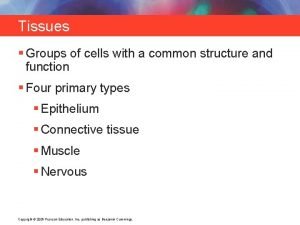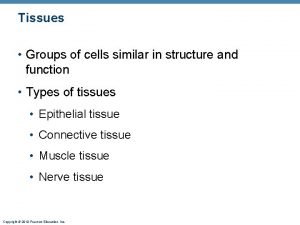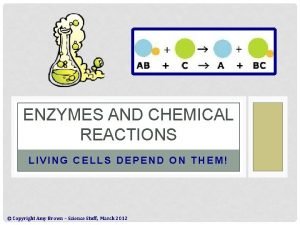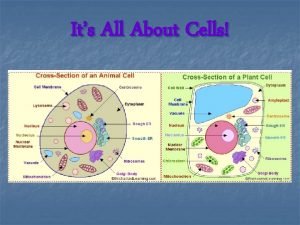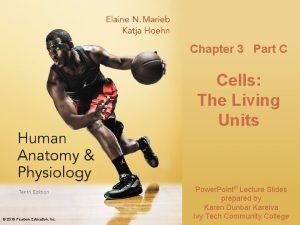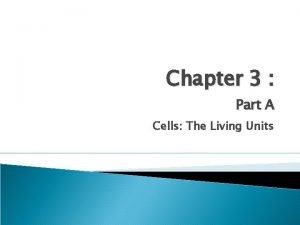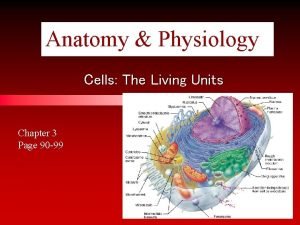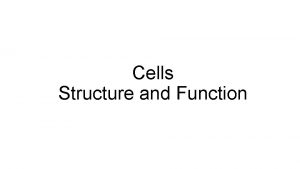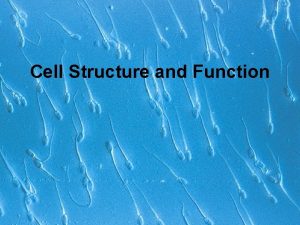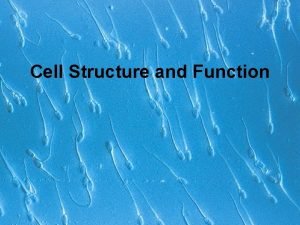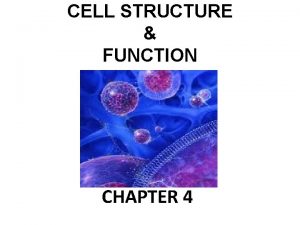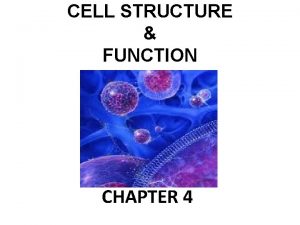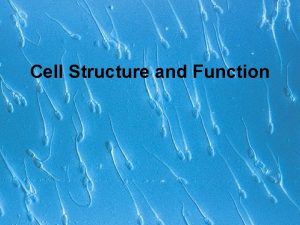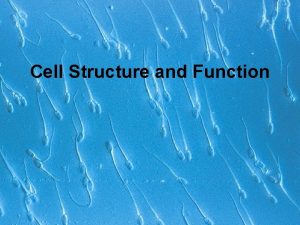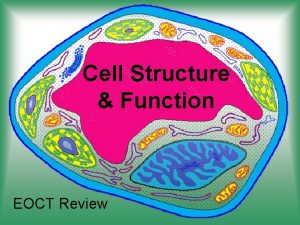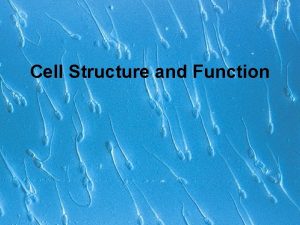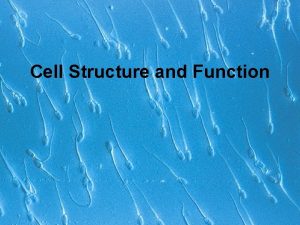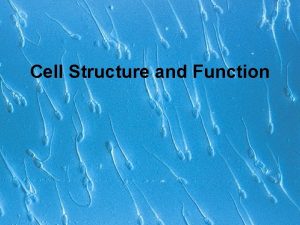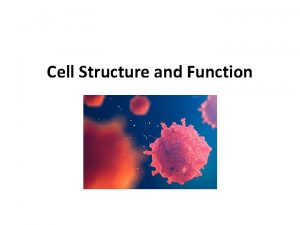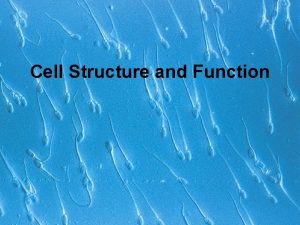Living Cells Structure Function of Cells Mr G




















- Slides: 20

Living Cells Structure & Function of Cells Mr G Davidson n o s id v a GD r M

Cellular Structure &Cells are the living units from which all organisms are made. &Simple organisms have only one cell and are unicellular, e. g. bacteria. &Other organisms have many cells working together and are multicellular, e. g. humans. 1/5/2022 Mr G Davidson 2

Animal Cell Structure Cell membrane Nucleus Cytoplasm 1/5/2022 Mr G Davidson 3

Animal Cell Structure Function Nucleus Controls cell activities and passes on information to the next generation Cytoplasm Site of all biochemical reactions Cell membrane Controls what enters and leaves the cell 1/5/2022 Mr G Davidson 4

Plant Cell Structure Nucleus Cell wall Cell membrane Vacuole 1/5/2022 Cytoplasm Chloroplast Mr G Davidson 5

Plant Cell Structure As well as the same structures found in animal cells, the following structures are also found in plant cells only. Cell Structure Function Chloroplast Contains chlorophyll which traps light energy to be used in photosynthesis Cell wall Made of cellulose and supports the structure of the cell Vacuole Stores water and solutes as a solution called “cell sap” 1/5/2022 Mr G Davidson 6

Cellular Structure &Cells are too small to be seen with the naked eye. &We use a light microscope to study cells. &Stains are often used to make certain parts of the cells more visible, e. g. &Methylene blue is often used to stain animal cells &Iodine solution is often used to stain plant cells. 1/5/2022 Mr G Davidson 7

Microbial Cells &A microbe is a microscopic unicellular organism. &Microbes are found almost everywhere that life can exist. &Microbes exist in huge numbers. &They can usually reproduce very quickly. 1/5/2022 Mr G Davidson 8

Microbial Cells &Some can cause disease and some can cause things to rot (decompose). &Others are useful, e. g. bread-making, wine-making, recycling, etc. . &There are different types of microbe, e. g. bacteria, yeast, etc. 1/5/2022 Mr G Davidson 9

Yeast &Yeast is a unicellular fungus. &Yeast cells are not mobile. &Yeast can be used to change sugar into alcohol and carbon dioxide in a process called fermentation. Yeast + Sugar 1/5/2022 Alcohol + Carbon dioxide Mr G Davidson 10

Uses of Yeast &Humans have made use of yeast for thousands of years for such things as: &Baking &Wine making &Brewing 1/5/2022 Mr G Davidson 11

Baking Yeast + Dough + Sugar 1/5/2022 Alcohol When the dough is cooked the alcohol evaporates + Carbon dioxide Mr G Davidson Carbon dioxide makes the dough rise 12

Wine Making Yeast + Sugar from fruits 1/5/2022 Alcohol + Carbon dioxide Alcohol used to make wines & spirits for drinking Alcohol can also be used as an alternative fuel Carbon dioxide is released as a waste product Mr G Davidson 13

Brewing Starch in barley changed to sugar Used to add flavour 1/5/2022 Yeast + Malted barley + Hops Alcohol used to make beers Alcohol + Carbon dioxide Alcohol can also be used as an alternative fuel Carbon dioxide is released as a waste product Mr G Davidson 14

Bacteria &Bacteria are useful for some things as well, such as making yoghurt. &Bacteria feed on a sugar found in milk called lactose. &This sugar is converted to lactic acid by the bacteria. &It is the lactic acid which turns the milk into yoghurt. 1/5/2022 Mr G Davidson 15

Antibiotics &Antibiotics are substances which prevent the growth of bacteria. &Penicillin was the first antibiotic and it was discovered by Alexander Fleming in 1928. &He was growing bacteria and discovered that a fungus has contaminated his plates and that no bacteria were growing near the fungus. 1/5/2022 Mr G Davidson 16

Alexander Fleming 1/5/2022 Mr G Davidson 17

Antibiotics Bacteria are less sensitive to this antibiotic Bacteria are resistant to this antibiotic “Clear area” indicates no bacterial growth 1/5/2022 Bacteria Mr G Davidson 18

Antibiotics &Many other antibiotics have now been discovered and they are produced by fungi. &Bacteria which cannot grow near an antibiotic are said to be sensitive to the antibiotic. 1/5/2022 Mr G Davidson 19

Antibiotics &Bacteria which do grow near an antibiotic are said to be resistant to the antibiotic. &A wide range of antibiotics are, therefore, required to combat the wide range of bacteria that exist. &There are effectively 2 groups of antibiotics: &Narrow-spectrum antibiotics which are useful against a few specific species of bacteria. &Wide-spectrum antibiotics which are useful against a wide range of species of bacteria. 1/5/2022 Mr G Davidson 20
 Muscle tissue parts
Muscle tissue parts Dense regular connective
Dense regular connective A group of cells similar in structure and function
A group of cells similar in structure and function Whats an energy pyramid
Whats an energy pyramid Is a seed living or nonliving
Is a seed living or nonliving Living non living dead
Living non living dead What is the smallest living unit in the body
What is the smallest living unit in the body Enzymes speed up chemical reactions by ____
Enzymes speed up chemical reactions by ____ Cells are the building blocks of all living things
Cells are the building blocks of all living things Are eukaryotic cells living or nonliving
Are eukaryotic cells living or nonliving Rough er
Rough er Chapter 3 cells the living units
Chapter 3 cells the living units Chapter 3 cells the living units
Chapter 3 cells the living units Sphenoid paranasal sinus
Sphenoid paranasal sinus Alpha intercalated cells
Alpha intercalated cells Thyroid gland
Thyroid gland Somatic cells vs gametes
Somatic cells vs gametes Why dna is more stable than rna?
Why dna is more stable than rna? Chlorocruorin
Chlorocruorin Prokaryotic vs eukaryotic transcription worksheet
Prokaryotic vs eukaryotic transcription worksheet Similarities between plant and animal cells venn diagram
Similarities between plant and animal cells venn diagram
